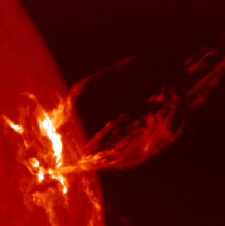

For more information about this mission, click on the figure.
Technology Requirements
- Solar sail propulsion and navigation
- Autonomous operation
- Miniaturized instrumentation
- Real-time solar wind data from 0.95 AU
Societal Benefits
- Understanding CMEs enables improved space
weather forecasts - Real-time data enables several-hour warning of
geomagnetic storms - Warnings of shock-acclerated particles enable
occupants of Space Station to take protective
measures
- Determine the three-dimensional structure of CMEs
- Study the evolution of CMEs during their transit from Sun
- Investigate stream interactions and interplanetary shocks in three-dimensions
- Investigate particle acceleration by CME-driven shocks and solar wind turbulence
Mission Description
- Delta launch to L1
- Three solar-sail spacecraft navigate to stations well inside L1
- Sentinel spacecraft orbit Sun with a 1-year period and adjustable separation
- Continuous operation, including real-time solar wind data
Measurement Strategy
- Solar wind plasma
- Interplanetary magnetic field
- Energetic particles
- Coordinated measuremetns at L1, L4, and L5 would be valuable